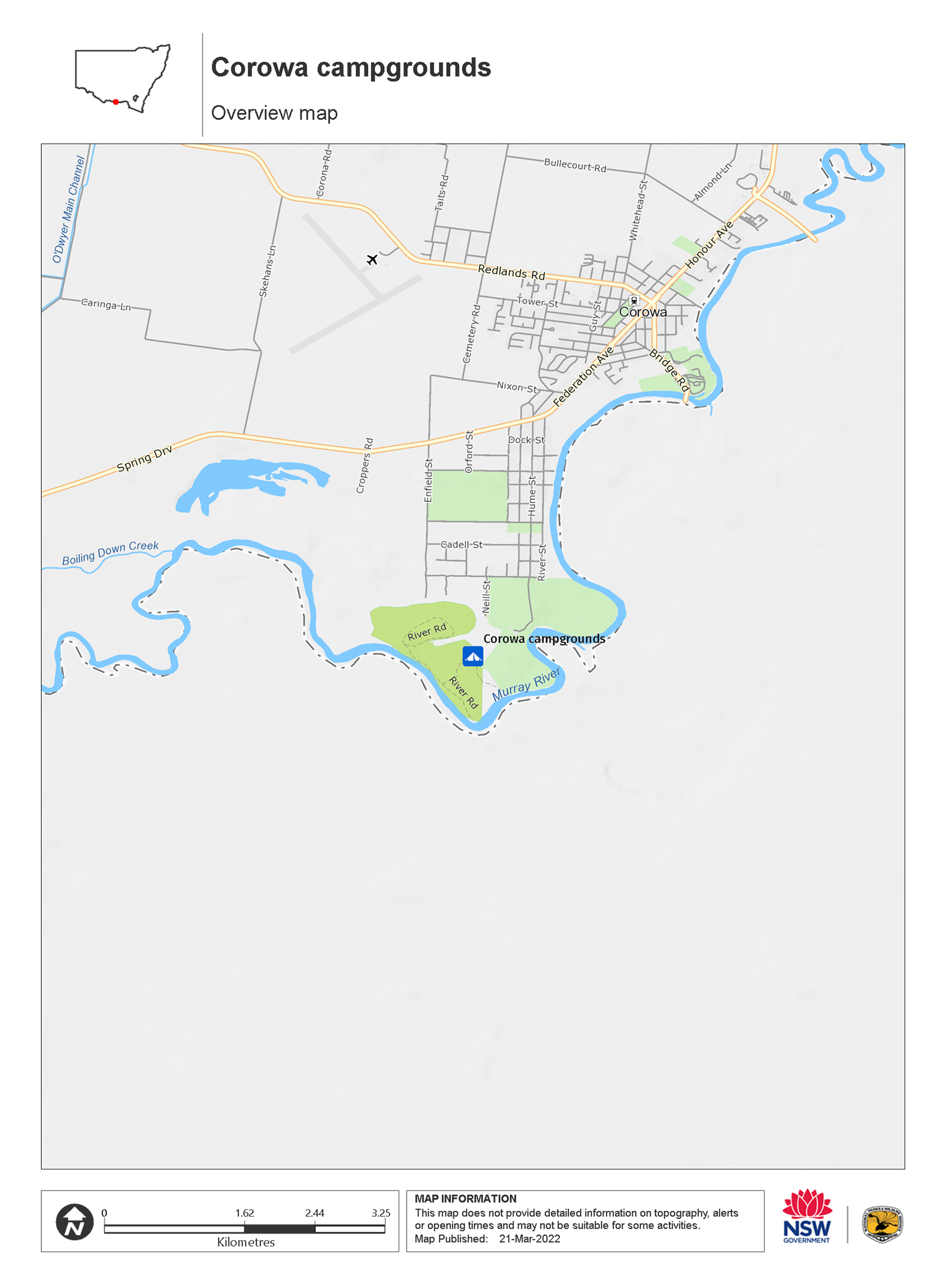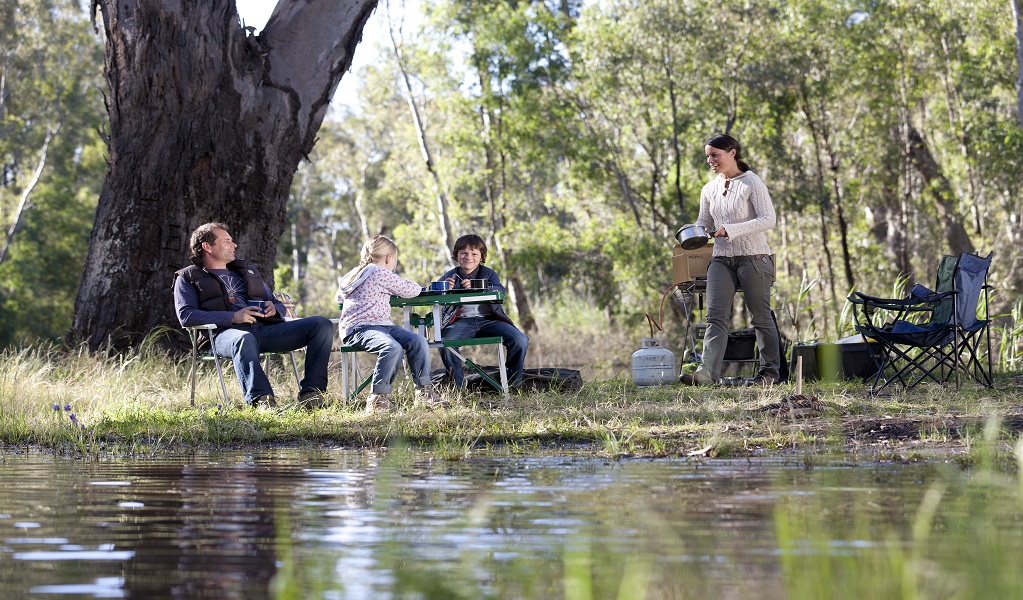Corowa campgrounds
Murray Valley National Park
Overview
Book a camping stay at Corowa campgrounds in Murray Valley National Park. Located just minutes from the township of Corowa, choose from 4 campgrounds to set up camp and fish along the mighty Murray River.
Choose from 4 campgrounds when you arrive:
- Hidden Beach campground
- Foords campground
- Federation campground
- Dairy Lagoon campground
There are no camping fees but a $6 booking fee applies. Bookings are required. Book online or call 1300 072 757.
Permitted
- Campfires are permitted between April and September.
- Collection of deadfall timber is permitted for small campfires only.
Prohibited
- You can’t remove firewood from the park. Chainsaws are not permitted.
- Pets and domestics animals (other than certified assistance animals) are not permitted in Murray Valley National Park. If you want to camp with your dog, find a campground in Murray Valley Regional Park.
Vehicle access and road quality
All roads leading to the campgrounds in the Corowa area are unsealed. 4WD vehicles recommended when wet.
How to get there
- From the Corowa Visitor Information Centre follow Edward Street for 1km.
- Turn left onto Federation Avenue and travel along for 1km.
- Turn left and follow Hume Street for 2.3km.
- Turn right onto Augusta Street and travel along for 500m
- Turn left onto Neill Street and follow the unsealed road to the entry gate.
- Follow Neill Street down along Dairy Lagoon, past the golf course and into the reserve where you can choose from 4 of the campgrounds..
Please note
There is an Occupational Permit held over this reserve which allows the Corowa Common Trust to graze cattle between November and April. When entering via Neill Street please be aware that the gate needs to be shut at all times.
There are no rubbish collection points. Please take all rubbish when you leave.
These maps give a basic overview of park attractions and facilities, and may not be detailed enough for some activities. We recommend that you buy a topographic map before you go exploring.
Map

Map legend

Local alerts
For the latest updates on fires, closures and other alerts in this area, see https://www.nationalparks.nsw.gov.au/camping-and-accommodation/campgrounds/corowa-campgrounds/local-alerts
Bookings
- National Parks Contact Centre
- 7am to 7pm daily
- 1300 072 757 (13000 PARKS) for the cost of a local call within Australia excluding mobiles
- parks.info@environment.nsw.gov.au
Operated by
- Moama office
- Monday to Friday, 9am to 4pm. Closed 12pm to 1pm.
- 03 5483 9100
- npws.riverina@environment.nsw.gov.au
- Factory 5, Lot 8 Bowlan Road, Moama NSW 2731
Park info
- in Murray Valley National Park in the Murray-Riverina region
Murray Valley National Park is always open but may have to close at times due to poor weather or fire danger.
Visitor info
All the practical information you need to know about Corowa campgrounds.
Maps and downloads
Learn more
Corowa campgrounds is in Murray Valley National Park. Here are just some of the reasons why this park is special:
Aboriginal heritage

The river red gum forests of the Murray Valley are the traditional Country for Aboriginal people. The landscape and all that it contains; rivers, forests, birds and animals are part of cultural beliefs and feature in Dreaming stories. The park provided a wealth of resources, including plants that were used as medicines and in tool making. The river was a rich food source; in some seasons the water was so clear and the fish plentiful. When you're exploring the park, keep your eyes open for Aboriginal sites, especially middens, oven mounds and scarred trees, where bark has been removed from the tree to make canoes, coolamons and shields.
An abundance of treasures

The Ramsar-listed Murray Valley wetland is home to over 60 threatened native animal species and 40 threatened plant species. Lay down the paddle of your canoe and sit in the silence, enjoying the company of egrets and cormorants, and keep an eye out for the superb parrot, slender and bright green. You may also see night herons, black swans, yellow rosellas, ducks, falcons, cockatoos, tree creepers, pardalotes, kingfishers and owls - this is truly a bird-lover's paradise.
- Moira Drive The scenic Moira drive takes you through the gorgeous river red gum forest around the mighty Murray River. Walk to the water bird observatory and stop for a picnic lunch.
- Murray River canoe trails These 4 canoe trails in Murray Valley National Park and Victoria’s Barmah National Park offer something for every paddler. Canoe the flowing Murray River, secluded creeks or Barmah Lake.
- Personalised birding tours around Deniliquin Keen birders will love these tailored outings by Australian Ornithological Services. They're a great way see rare and endemic birds, including plains wanderers, in the unique ecosystems near the outback town of Deniliquin.
- Reed Beds Bird Hide boardwalk It’s an easy walk along the boardwalk to Reed Beds Bird Hide, with fun things to do along the way. Listen to see how many different bird calls you can hear on the way.
River red gum country

This iconic landscape features the huge river red gums soaring from the banks of the Murray and wetlands that make up this part of the Riverina's important ecosystem. This new park, formed from a number of former state forests, is part of the largest continuous river red gum forest in the southern hemisphere and is an important and unique ecosystem.
- Moira Drive The scenic Moira drive takes you through the gorgeous river red gum forest around the mighty Murray River. Walk to the water bird observatory and stop for a picnic lunch.
- Personalised birding tours around Deniliquin Keen birders will love these tailored outings by Australian Ornithological Services. They're a great way see rare and endemic birds, including plains wanderers, in the unique ecosystems near the outback town of Deniliquin.
The paddle steamer era

The paddle steamer era ran from the 1860s to the early 1900s and was important for transporting people and supplies along the Murray River. Trees along river were marked with large numbers cut into the bark, spaced 1-mile (1.6km) apart from Albury to Wentworth. The numbers represented the distance in miles from Albury and were made during a government survey of the Murray River from 1868 to 1872. Some of these markings can still be seen today.
Plants and animals protected in this park
Animals
-

Australian pelican (Pelecanus conspicillatus)
The curious pelican is Australia’s largest flying bird and has the longest bill of any bird in the world. These Australian birds are found throughout Australian waterways and the pelican uses its throat pouch to trawl for fish. Pelicans breed all year round, congregating in large colonies on secluded beaches and islands.
-

Eastern snake-necked turtle (Chelodina longicollis)
Found across most of NSW, the eastern snake-necked turtle, also known as the eastern long-necked turtle, can be found in swamps, lakes and inland waterways. This freshwater turtle is carnivorous and lives most of its life submerged on the water’s edge, searching for worms and snails.
-

Kookaburra (Dacelo novaeguineae)
Of the 2 species of kookaburra found in Australia, the laughing kookaburra is the best-known and the largest of the native kingfishers. With its distinctive riotous call, the laughing kookaburra is commonly heard in open woodlands and forests throughout NSW national parks, making these ideal spots for bird watching.
-

Common brushtail possum (Trichosurus vulpecula)
One of the most widespread of Australian tree-dwelling marsupials, the common brushtail possum is found across most of NSW in woodlands, rainforests and urban areas. With strong claws, a prehensile tail and opposable digits, these native Australian animals are well-adapted for life amongst the trees.
Plants
-

River red gum (Eucalpytus camaldulensis)
Australian native plants, majestic river red gum trees are widespread across Australian inland river systems. The river red gum is a dominant tree species of the Murray-Darling basin which spans NSW, Queensland and Victoria. This iconic native eucalypt grows to a height of 30m and is thought to have a lifespan up to 500-1000 years.

